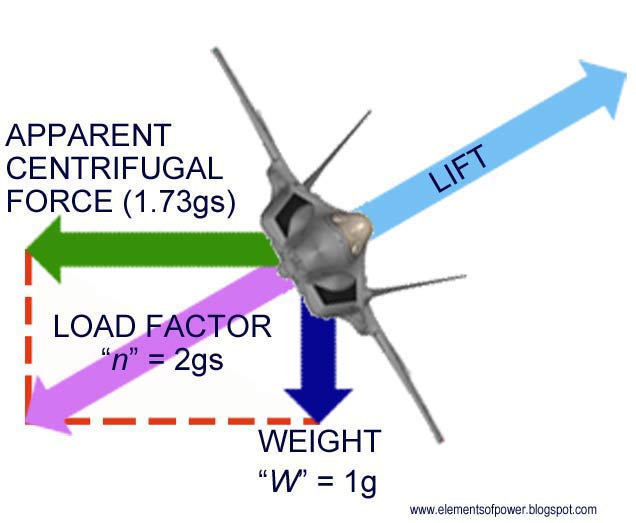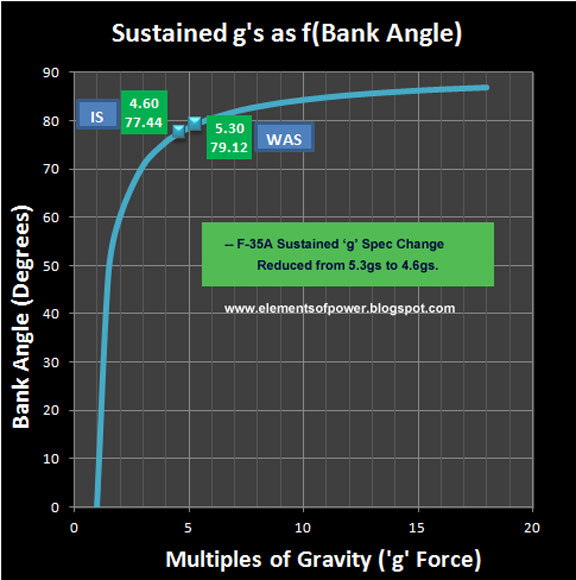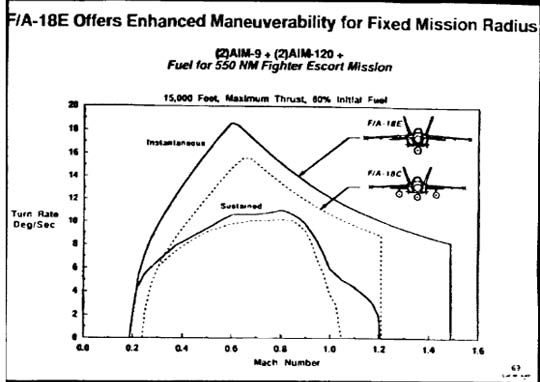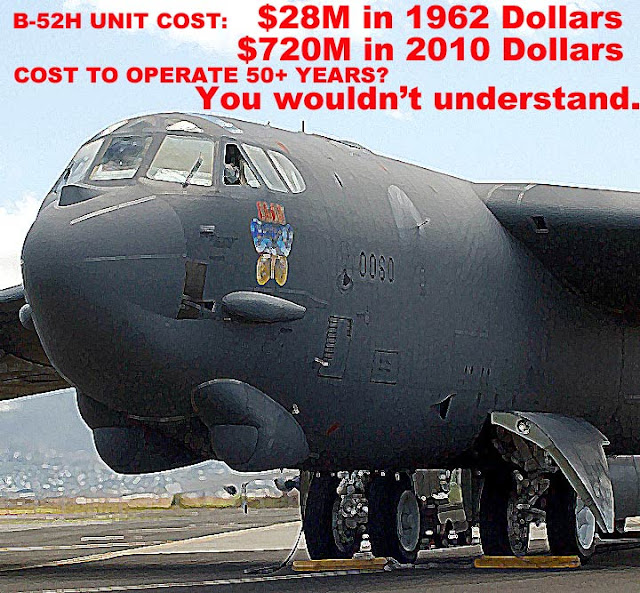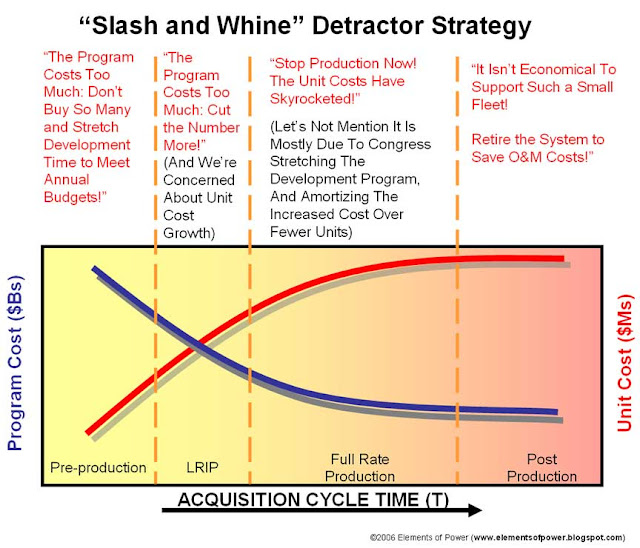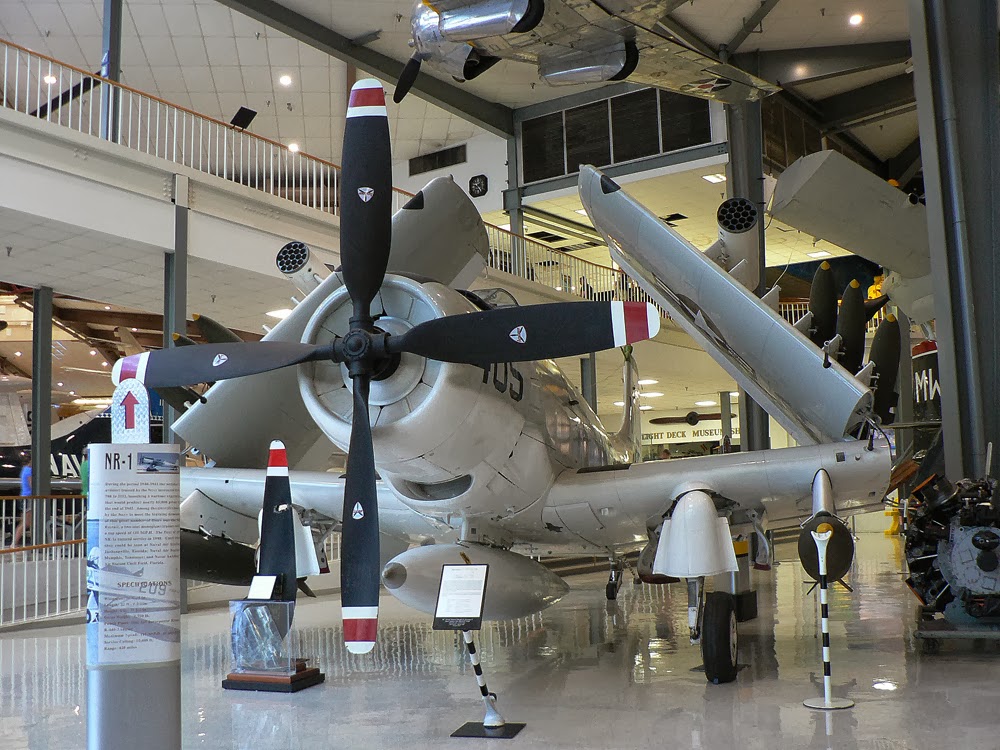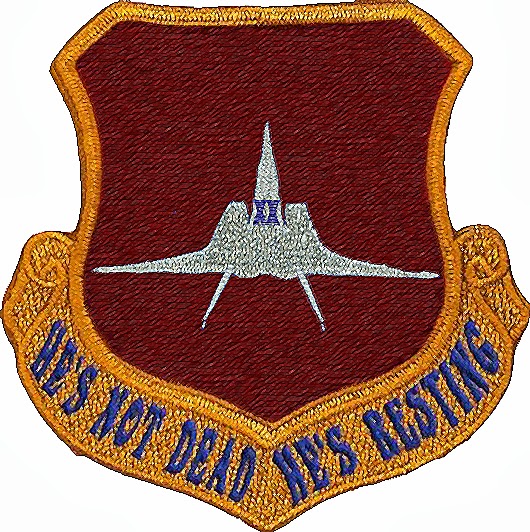Because if you learned all you know about E-M from Boyd, you’re only about a half-century behind the learning curve
Housekeeping
The first two things to remember in this kind of discussion are:1. Performance metrics are used as PROXIES for what is important in a Weapon System under acquisition or already fielded. The metrics are NOT important in and of themselves. They are only as important as the degree to which they inform developers and operators on the system’s true versus desired capabilities.
and...
2. Weapon system specifications are initially established based upon what is believed to be needed and what is believed to be feasible within the projected budget and schedule before the development is given the ‘go-ahead’. There are only varying degrees of assumed confidence in the ability to achieve what is seen as feasible, and this depends much on perceived technology maturity. Only after the project is underway will the need and/or feasibility, given the actual maturity and budget, begin to be revealed, and it may be only truly knowable towards the end of development. Adjusting the specifications as new information is acquired, while still meeting Warfighter needs is sound engineering and management. It is NOT (as someone in the POGO crowd or ‘low information media’ might claim) “cheating” or a sign of “failure”.
Beyond Boyd: A Quick Survey of the Evolution AFTER the E-M Revolution
I’ve picked two AIAA papers on the subject to illustrate the post-Boyd reality: one from from the 1980’s and one from the 1990’s. There are a fairly large number of scholarly papers concerned with the inadequacy of the traditional Boyd ‘E-M diagram’ that lead right on up to the present day, but as T. Takahashi observed just last year in a paper proposing yet another ‘better way’ to visualize E-M:For aircraft whose missions demanded combat maneuverability, the United States Air Force required production of Energy-Maneuverability (E-M) plots. The design of the F-14, F-15, F-16 and F-18 was tailored by designers working to better the E-M capability of Soviet aircraft. In this context, a government oversight driven tradition developed where industry was required to plot many aerodynamic and aircraft performance parameters as functions of speed and altitude.To begin our review, I think one of the better overviews of how E-M factors evolved post-Boyd is encapsulated in a paper by Skow, Hamilton and Taylor (1985). They observed:
“In the late 1940's and early 1950’s, with the advent of jet propulsion, radical new wing designs and greatly expanded flight envelopes, a corresponding need for more definitive measures of merit for aircraft performance comparisons was generated. When the "century series" fighters were developed and rear-aspect IR missiles became the principal air-to-air combat weapon, point performance comparisons were found to be inconclusive and insufficient to predict superiority. Out of this need, energy-maneuverability (E-M) concepts were formulated and developed. In the 1960's. E-M came into widespread use by aircraft designers and fighter pilots. E-M provided an analog picture of a fighter's performance capabilities over a range of velocities and altitudes. It gave quantifiable credit to measures of merit which allowed the advantages of speed (energy) and turning (maneuverability) to be balanced. These measures of merit were shown to be dominant in determining the outcome of an air battle at that time.
...
But, as they say, time marches on, and in the past 10-12 years, several significant advancements have been made in the capabilities of fighter aircraft and air-to-air weapons. Three of these advancements; the all-aspect IR missile, greatly improved weapons delivery systems, and high thrust-to-weight engines have dramatically altered the character of the air battle, especially the close-in fight. The modern air battle is characterized by (1) time compression – shorter duration maneuvering required and (2) harder maneuvering - nose position at the expense of energy vs. nose position with energy conservation…
Air combat trends have expanded to ever increasing altitudes and speeds for beyond visual range (BVR) combat and conversely have tended to a lower and sometimes slower arena for close-in, within visual range (WVR) combat. … …This changing complexion of air combat, primarily due to the all-aspect IR missile, has altered the relative significance of the various performance characteristics with which we judge relative merit. Table 3 depicts the more common agility characteristics with some relative rankings.”
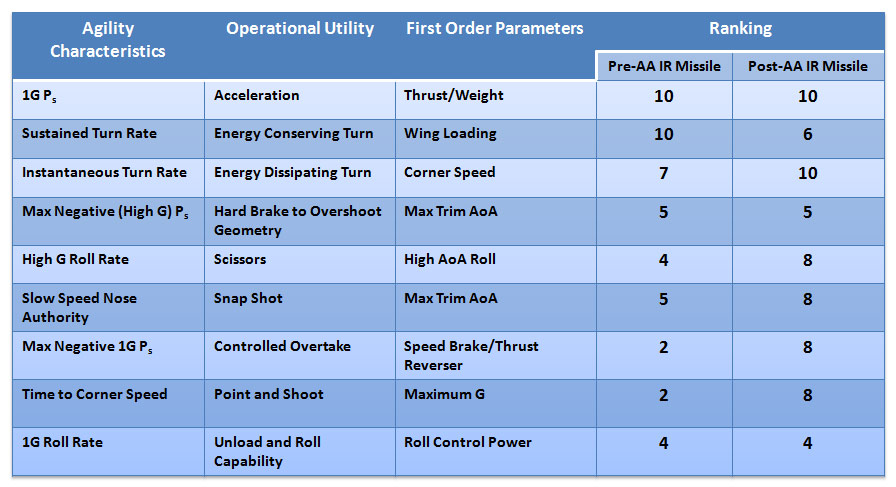 |
Table 3 Reconstruction from “Advanced Fighter Agility Metrics” |
During the Korean War and the Vietnam conflict, jet fighter aircraft emerged with greatly expanded altitude and Mach ranges. This era also saw the advent of the short range heat seeking missile. These missiles required maneuvering to achieve a rear-aspect firing position. The measures of merit, altered to match the increase in aircraft capability, were advanced point performances (thrust-to-weight ratio, maximum Mach number, sustained turn rate, etc.) and the energy-maneuverability performance method. In recent years, the level of fighter aircraft and weapon system technological sophistication has reached new heights; the most critical advance being the development of the all-aspect infrared missile. This missile negates the requirement of maneuvering to achieve a rear-aspect firing position and concurrently has caused the traditional point performance measures of merit to become deficient for determining the combat effectiveness of a fighter aircraft. To remedy this deficiency, new measures of merit are being investigated which examine aircraft maneuver and control capabilities not previously quantified.We could dive deep into discussion on each metric proposed in this paper, but I would like to focus on Tamrat’s Combat Cycle Time, as it is what differs most from the pioneering but simpler Boyd-Era POV of E-M, and the authors ably describe how Tamrat builds on same:
Traditionally, the need to achieve a rear-aspect position for a gun or missile firing opportunity led fighters to engage in battles lasting several minutes. These engagements were characterized by sustained maneuvering. This type of combat made the turn rate verses Mach number diagram (doghouse plot) useful for determining one fighter's advantage over another. When maneuvering for a rear-aspect firing solution, the interior of the doghouse plot is important. This interior region is represented by the sustained turn rate line and is typically dictated by available thrust and the lift to drag ratio of the aircraft. The compressed time scales of today's air combat arena have made sustained maneuvering less critical. The desire for a first shot opportunity leads to fights dominated by transient load factor/lift limited maneuvers. The emphasis then is shifting toward more dynamic maneuvering or the exterior of the doghouse plot. Figure 1 shows these critical regions on a conceptual doghouse plot.
 |
| From "Evaluation Of Functional Agility Metrics For Fighter Class Aircraft" |
The first region is the dynamic pressure limit line (A) along which pitch rate is used to load the aircraft to enter a turning situation. Next, flight path and nose pointing maneuvers occur along the limit load factor and lift limit boundaries (B). The time to unload the aircraft is shown as the region in between the lift limit line and the 1-g line (C). The last critical region shown is the 1-g acceleration (D) in which an aircraft regains lost energy to leave the engagement or enter a turn to pursue another target. The Combat Cycle Time metric, developed by B.F. Tamrat combines these four critical regions into a single parameter. The time for each maneuver segment is calculated and then summed to obtain a time for the entire maneuver cycle. The critical regions, segment times, and corresponding maneuvers are:
A t, pitch up to load factor limit
B t, turn along load factor and lift limit
C t3, unload from elevated AOA/load factor
D t4, regain original energy level
The Combat Cycle Time metrics offers an advantage over traditional measure of merit for turning maneuvers. The doghouse plot shows the sustained and instantaneous turn rates for only one flight condition (i.e. specified power setting, mach, altitude, altitude, weight, etc.). The Combat Cycle Time, however, is characterized by a continually changing flight condition constrained within structural, lift, and power limits.
What it All Means
If there are recurring themes over the years in all the proposed metrics that move beyond Boyd/ Christie’s E-M diagram paradigm, it is 1) All-aspect missile attack changed the game and 2) the proposed metrics try to account for the missing values of the speed of ‘transition’: the time needed to point the aircraft in a desired direction from another, the ability to decelerate as well as accelerate in vertical and the horizontal, to change pitch, roll and yaw.The lingering deference to standard E-M charting in the operational world springs more from their relative ease of understanding by non-engineer aircrew and government bureaucrats than from their utility. The E-M diagrams benefit from the fact that what really counts, is harder to explain. So we lumber along with the deficient E-M charting and rely on the ability of the untrained/uninterested to recognize the important nuances.
One of the biggest impacts on aircraft E-M performance that isn’t in the vehicle’s dynamics vis a vis the external environment (but sometimes dealt with in the OODA loop) is the man-machine interface: how fast the pilot perceives a change/threat and reacts to or preempts the effect of the change/threat by changing the vehicle dynamics. How well can the crew execute the mission in light of all the factors that could diminish the pilot’s ability to manage change and threats? Factors such as: How much attention does he have to pay to not bending or breaking the airplane or keep from departing controlled flight while engaged in the fight?
Limitations of Boyd-Era E-M Proxies and the F-35
A good example of the limitations of the traditional metrics is found in the caterwauling over the recent change in the F-35’s sustained-g turn standard from 5.3 to 4.6gs at some pre-selected altitude and speed. So much hang-wringing and finger-pointing—coming from those who not only do not know how important or unimportant the change was to needed/desired overall aircraft performance, but for the most part also have no idea what the change meant in and of itself, in ‘performance’ terms.That, friend Reader, is a good lead-in for my next post (or two). Examine the reconstructed ‘Table 3’ above and ponder how the F-35 (especially the F-35A) performance stands up in the post-Boyd air combat world.
We'll soon engage in some speculative analysis on the F-35, but the speculation will be based upon logic, facts, physics, and experience.
References:
AIRCRAFT CONCEPT DESIGN PERFORMANCE VISUALIZATION USING AN ENERGY-MANEUVERABILITY PRESENTATION; Timothy T. Takahashi; AIAA 2012-5704ADVANCED FIGHTER AGILITY METRICS; Andrew M. Skow, Willlam L. Hamilton, John H. Taylor; AIAA-A85-47027
EVALUATION OF FUNCTIONAL AGILITY METRICS FOR FIGHTER CLASS AIRCRAFT; Brian W. Cox, Dr. David R. Downing; AIAA-92-4487-CP





